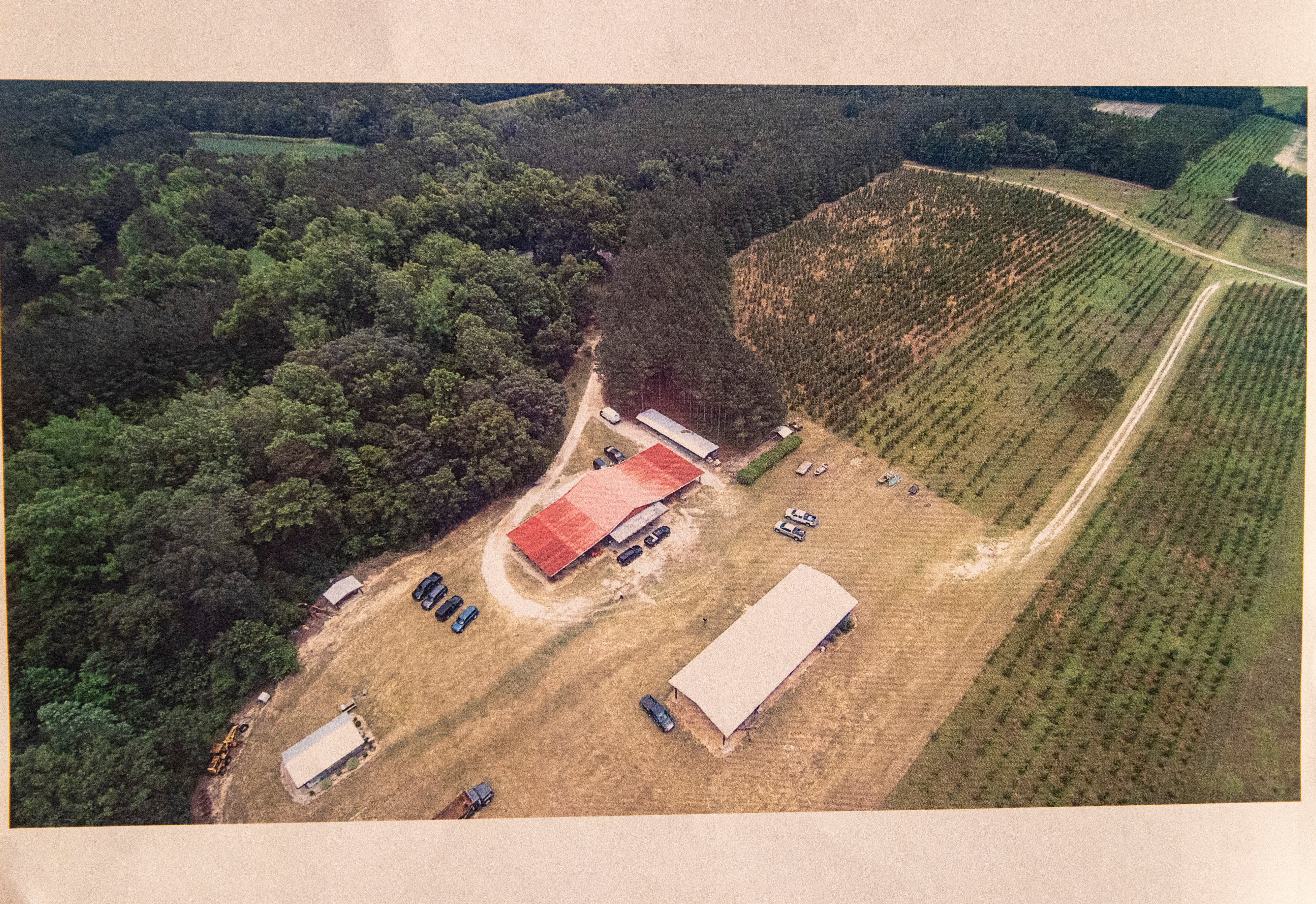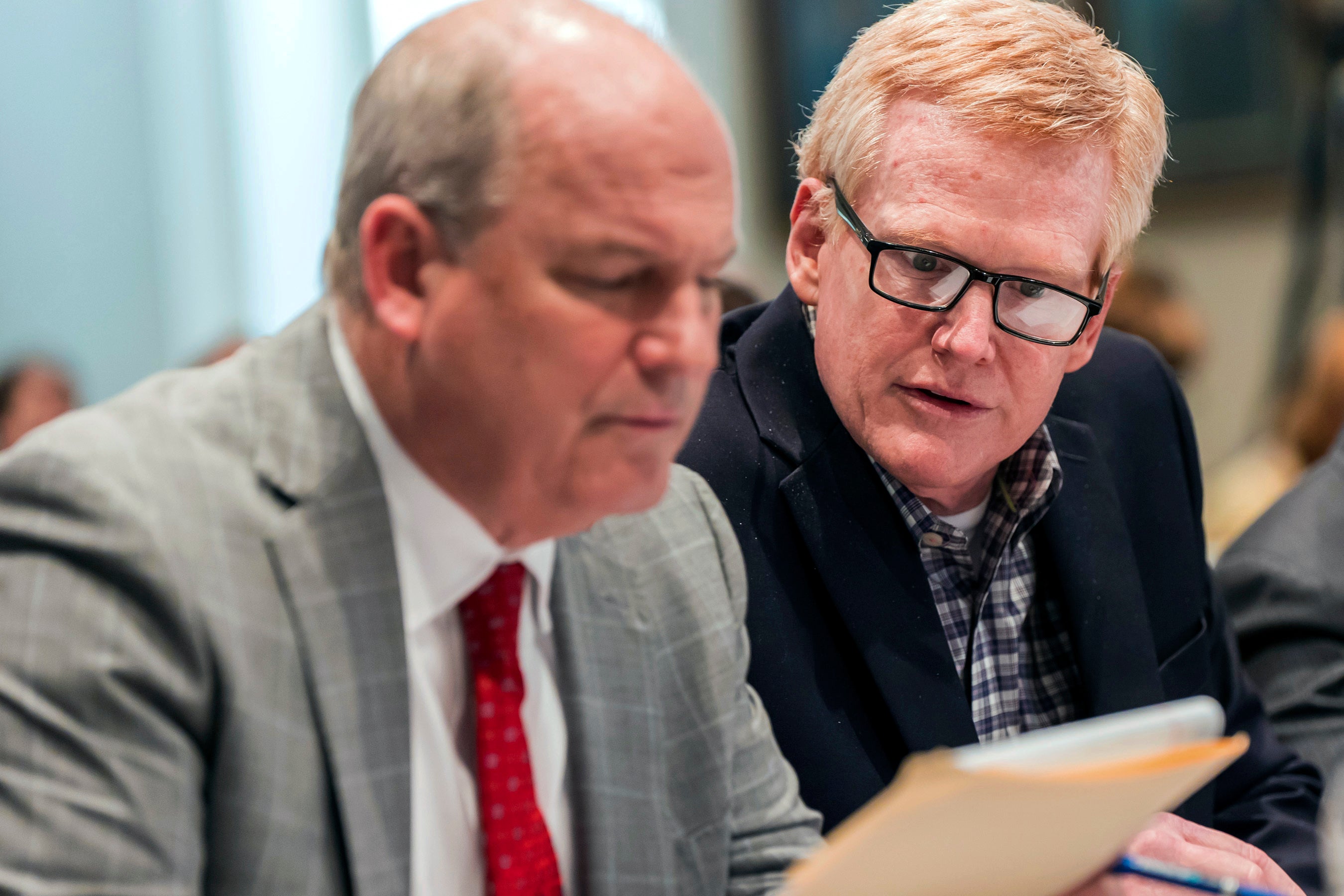
South Carolina’s top prosecutor pointed a shotgun at a witness’s head during Alex Murdaugh’s double murder trial in a dramatic attempt to disprove the defence’s “unscientific” theories about the murders of Maggie and Paul.
Dr Kenny Kinsey, an Orangeburg County sheriff’s deputy and crime scene expert, returned to the witness stand at the Colleton County Courthouse in Walterboro, South Carolina, on Tuesday afternoon as the prosecution wrapped up its case against the disgraced attorney.
In a graphic demonstration in the courtroom, Dr Kinsey and South Carolina Attorney General Alan Wilson acted out the defence’s version of how Paul was murdered – with the killer shooting him in the back of the head at point-blank range.
Dr Kinsey rubbished what he described as a “preposterous” and “unscientific” theory from the defence as he went into gruesome detail about the extent of injuries he has seen on victims who have suffered a contact wound to the head with a shotgun.
The crime scene expert also tore apart testimony from another defence witness who had claimed that Maggie was murdered by a 5’2” shooter – and not her 6’4” husband.
Maggie and Paul were both gunned down at the family’s Moselle hunting estate in Islandton, South Carolina, on 7 June 2021.
Paul, 22, was shot twice with a 12-gauge shotgun as he stood in the feed room of the kennels.
The first gunshot struck his chest and wasn’t fatal, while the second struck him in the shoulder, neck and head – with the bullet blowing his brain completely out of his skull.
Maggie, 52, was then shot five times with a .300 Blackout semiautomatic rifle as she tried to flee from her killer.
On Monday, two defence experts – forensic pathologist Dr Jonathan Eisenstat and crime scene analyst Tim Palmbach – both testified that they disagreed with the prosecution’s account of how the murders unfolded.
Instead, they claimed that – after firing the first shot – the killer stepped into the feed room towards Paul. Then, the killer held the shotgun to the back of Paul’s head as he was bent over and pulled the trigger.
The force then caused the 22-year-old’s brain to “explode” out of his skull and the gun pellets to pass down into his shoulder and neck, they claimed.
The contact-wound theory disputed the testimony of Dr Ellen Riemer, who performed autopsies on the bodies of the two victims. Dr Riemer said that the shooter fired from outside the feed room and the second, fatal shot had entered his shoulder and neck first, before travelling up to Paul’s brain.

AG Wilson – whose questioning of Dr Kinsey marked his first appearance in the high-profile trial – told jurors he was practicing gun safety but that Dr Kinsey had asked him to point the gun at him so that they could demonstrate how the theory of Paul being shot at point-blank range was incorrect.
Dr Kinsey testified that the state of the crime scene was inconsistent with the defence’s theory, saying that this wouldn’t have caused blood, brain and other biological matter to hit the doorframe of the feed room.
“To think that the pressure from flesh and bone will cause that pellet ….those steel pellets… They will turn around because of that pressure and go back the opposite direction, a 180 degree direction at enough velocity to hit an exterior and embed in the doorframe that doesn’t happen, that doesn’t happen in my opinion,” he said.
He also said that there were “no defects to the exterior panelling at the bottom of doorway” explaining “this shot has to go somewhere”.
“I think that is preposterous in my opinion,” he said of the defence’s version of events.
Dr Kinsey said that Paul’s wounds were also inconsistent with the injuries he has seen on around three dozen individuals who were shot at point-blank range in the head – both suicides and homicides.
He went into graphic detail about the state of the heads and faces he had seen in those victims.
“They’ve been shredded... but looking at it it looks like from the teeth of the person went away... it’s just a mess,” he said.

“Often the eyes will pop out,” he said, adding that the “facial bones will move round” and pieces of pellet gather in the skin.
Paul’s injuries were not consistent with this, he said.
The expert also said he had “zero confidence” in the testimony of defence witness Mike Sutton, who suggested that Maggie’s killer was only 5’2” tall. Mr Murdaugh is 6’4”.
Mr Sutton, a forensic engineer who specialises in external ballistics, previously testified that the person who shot Maggie had to be 5’2” to 5’4” based on the projection of the bullets at the crime scene.
Jurors had been shown 3D animations created of the area around the dog kennels and the feed room. The animation included images of two grey anonymous shooters and green straight lines said to show the angles of the bullet trajectories.
Mr Sutton had used the angles to create green laser lines and placed animated figures on the lines to find a height that matches.
Dr Kinsey smirked when he was asked about the animation and said that to reach a conclusion about both the angle of the bullet trajectories and the shooter’s height was “unscientific”.
Dr Kinsey told the court that he disagreed “wholeheartedly” that it would even be possible to determine the angles that the shooter fired from, and thereby the height of the person pulling the trigger.
“The notion of being able to look at this evidence and say that… it’s unscientific,” he said.
“It’s an unknown. There so many variables,” he said.
He said that there are too many variables to be able to determine the angles of the bullets, whereas Mr Sutton assumed the bullet travelled perfectly straight.
Dr Kinsey explained that the angles of bullets can change if they hit something, and that grooves inside the barrel of the firearm can also change the angle of bullets travelling.
Without the murder weapon, he said it was also not possible to test how the gun spits out shell casings to determine roughly where the shooter was standing when the firearm was fired.
“I have zero confidence from this piece of evidence as far as establishing angles,” Dr Kinsey said of the animation.

Even if the angles were correct, Dr Kinsey said that there are “a bunch of variables” to determining the height of the shooter including the fact that “this was a very dynamic crime scene” with both the killer and the victim moving.
“You’d have to consider this to be a static crime scene. Very little movement,” he said of the defence witness’s theory.
In his opinion, a 6’4” person could “absolutely” have shot Maggie from the angles the defence team claimed.
Dr Kinsey testified that it would not be possible to determine the shooter’s height with the available information, saying they “could have been a 5’4”, a 6’4” or a 7’4”.”
The crime scene expert marked the last rebuttal witness before the prosecution rested its case on Tuesday afternoon.
During the rebuttal case, the prosecution picked apart the defence’s expert witness testimony about the murders.
The state also sought to show jurors how Mr Murdaugh had continued to lie when he took the stand in his own defence last week – with two of the accused killer’s friends and colleagues, and a law enforcement officer disputing key aspects of his testimony.
On Wednesday, jurors will be taken on a field trip to the Moselle property to see the crime scene where the brutal murders took place for themselves.
At the property, jurors will tour the dog kennels and feed room on the estate where Maggie and Paul were shot dead back on 7 June 2021.
After that, closing arguments will get under way before the jury begins deliberations in the case.
It is possible that, by the end of the week, the disgraced attorney and accused killer will know his fate.
The defence rested its case on Monday after calling 14 witnesses – including Mr Murdaugh’s surviving son Buster and brother John Marvim – over the course of one week as the legal team seeks to try to convince jurors of Mr Murdaugh’s innocence.
The defence’s case also sought to pick holes in the prosecution’s case and cast doubts on the validity of the investigation, while pushing a theory that two shooters may have carried out the attack.
The defence case came after jurors heard four weeks of dramatic testimony from the prosecution, covering a trove of circumstantial evidence, including cellphone and car data and numerous apparent holes in his alibi for the time for the murders.
Prosecutors claim Mr Murdaugh killed his wife and son to distract from his string of alleged financial crimes – at a time when his multi-million-dollar fraud scheme was on the brink of being exposed.
Mr Murdaugh is facing life in prison for the murders of Maggie and Paul and has pleaded not guilty.
Beyond the murders, the brutal double murders brought to light a series of scandals surrounding Mr Murdaugh including unexplained deaths, a multi-million-dollar fraud scheme and a botched hitman plot.






